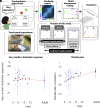Comparing color qualia structures through a similarity task in young children versus adults
- PMID: 40067901
- PMCID: PMC11929397
- DOI: 10.1073/pnas.2415346122
Comparing color qualia structures through a similarity task in young children versus adults
Abstract
Examination of the subjective qualitative aspects of an experience, or "qualia" in short, is a fundamental and core aspect of consciousness research. How can we characterize the particular quality of redness, i.e. a red quale? Based on a recent proposal of the structural characterization of qualia, which did not rely on verbal descriptions, we developed a task that obtained pairwise similarity judgments at four graded levels, with easy and intuitive visual interfaces designed to engage young children. We examined color qualia structures in children (3 to 12-y-old in Japan and 6 to 8-y-old in China) and compared these with those of Japanese adults. Approximately half of the assessed 3-y-old children completed the experiment via our touch panel device version of the task and had reliable responses. Despite known developmental and/or cultural effects of color term usage, we found that color qualia structures were quite similar across the age groups and cultures. Our finding supports the view that color qualia structures emerge early. We also observed age-related differences in the evaluations of some color pairs, which implied subtle changes in the structures behind color experience.
Keywords: children; color; consciousness; development; qualia.
Conflict of interest statement
Competing interests statement:The authors declare no competing interest.
Figures




References
-
- Crick F., Koch C., Consciousness and neuroscience. Cereb. Cortex 8, 97–107 (1998). - PubMed
-
- Dehaene S., Naccache L., Towards a cognitive neuroscience of consciousness: Basic evidence and a workspace framework. Cognition 79, 1–37 (2001). - PubMed
-
- Kanai R., Tsuchiya N., Qualia. Curr. Biol. 22, R392–R396 (2012). - PubMed
-
- Dennett D. C. “Quining qualia” in Consciousness in Contemporary Science, Marcel A. J., Bisiach E.. Eds. (Clarendon Press/Oxford University Press, 1988), pp. 42–77.
Publication types
MeSH terms
Grants and funding
- 20H05710/MEXT | Japan Society for the Promotion of Science (JSPS)
- 23H04830/MEXT | Japan Society for the Promotion of Science (JSPS)
- 23H04832/MEXT | Japan Society for the Promotion of Science (JSPS)
- 23H04835/MEXT | Japan Society for the Promotion of Science (JSPS)
- DP180104128/Department of Education and Training | Australian Research Council (ARC)
LinkOut - more resources
Full Text Sources

